Advantages and Disadvantages of Generative AI and Conversational AI

Generative AI and conversational AI are transforming the way businesses interact with customers. Generative AI focuses on creating content, like text or images, based on patterns it learns. On the other hand, conversational AI is designed to have human-like chats with users, making it perfect for customer support.
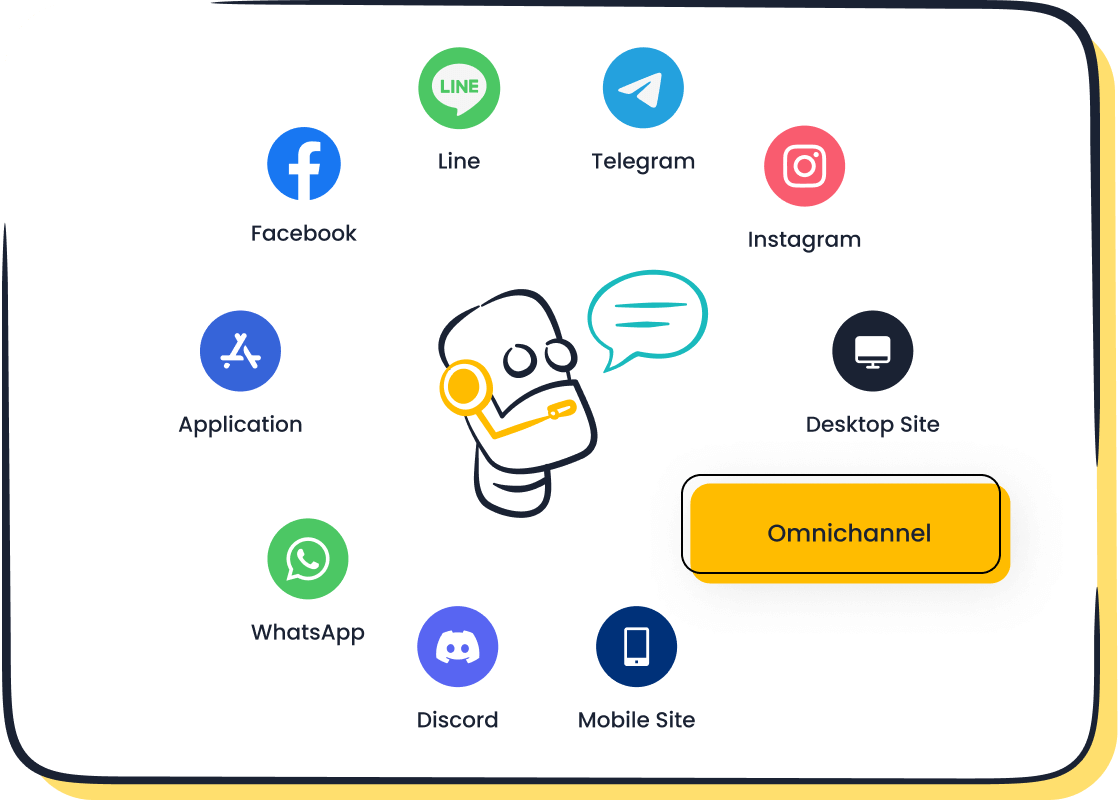
Why does this matter to you? These technologies save time, cut costs, and improve customer satisfaction. For instance, by 2025, 80% of companies plan to use AI-powered chatbots for customer service. Tools like Sobot’s AI Chatbot automate repetitive tasks, handle queries 24/7, and boost agent productivity by 70%. Understanding the pros and cons of generative AI vs conversational AI helps you adopt the right tools for your business.
Advantages of Generative AI in Customer Service

Enhancing Creativity and Personalization
Generative AI is a game-changer when it comes to creativity and personalization. Imagine being able to craft unique customer experiences tailored to individual preferences. With large language models (LLMs), businesses can analyze customer data and generate personalized responses, product recommendations, or even marketing messages. This level of personalization at scale helps you connect with your customers on a deeper level.

For example, 82% of customers expect companies to use digital tools to enhance their services. Generative AI makes this possible by creating dynamic, engaging content that resonates with your audience. Whether it’s crafting a personalized email or suggesting products based on browsing history, the possibilities are endless. Tools like Sobot’s AI Chatbot leverage LLMs to deliver these personalized experiences across multiple channels, ensuring your customers feel valued and understood.
Tip: Personalization isn’t just a buzzword—it’s a proven strategy to boost customer engagement and loyalty. Start small by integrating AI into your customer-facing applications and watch the magic happen.
Automating Content Creation for Customer Engagement
Creating content manually can be time-consuming and expensive. Generative AI simplifies this process by automating content creation, allowing you to focus on strategy rather than execution. From generating FAQs to crafting social media posts, AI-powered tools can handle it all. This automation not only saves time but also ensures consistency across your customer-facing applications.
Here’s how automation impacts customer engagement metrics:
| Metric | Improvement |
|---|---|
| CSAT Score | 1% increase |
| Repeat Purchases | 36% increase |
| First Response Time | 37% reduction |
| Resolution Time | 52% reduction |
| Ticket-to-Order Ratio | 27% decrease |
Generative AI, powered by advanced LLMs, can even create multilingual content, making it easier to engage with a global audience. Sobot’s AI Chatbot, for instance, uses generative AI to automate responses in multiple languages, ensuring seamless communication with customers worldwide. This not only enhances customer engagement but also boosts your team’s productivity.
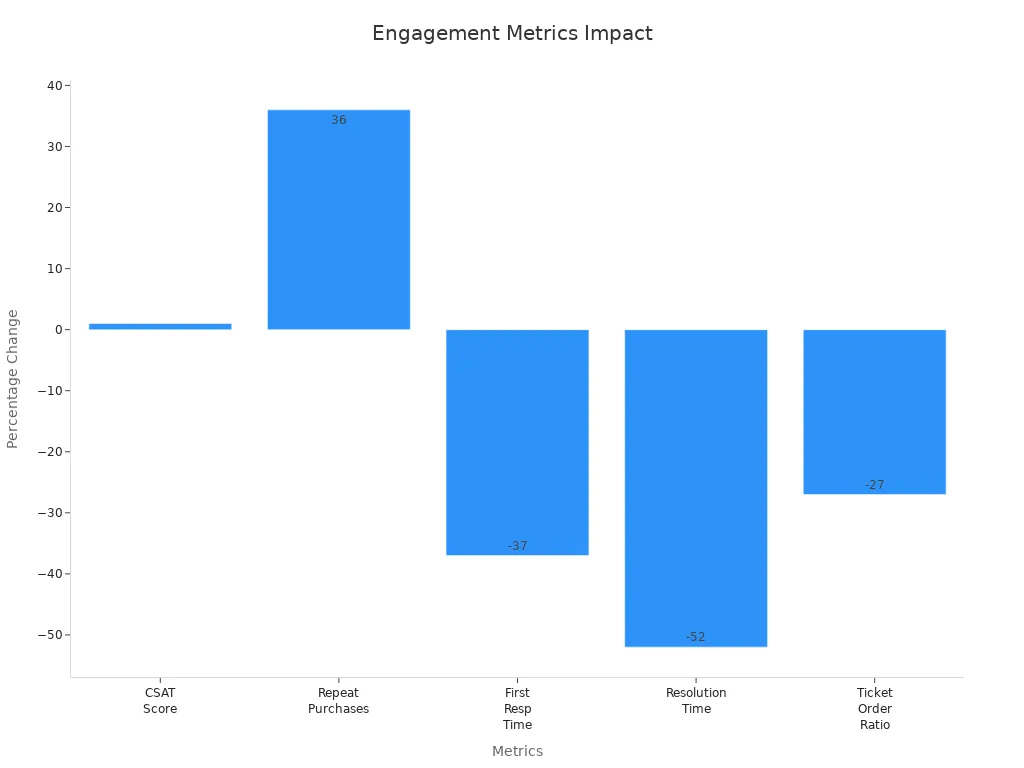
Boosting Productivity and Efficiency in Contact Centers
Generative AI doesn’t just improve customer interactions—it also transforms the way your contact center operates. By automating repetitive tasks, it frees up your agents to focus on more complex issues. This leads to improved productivity and better customer satisfaction.
A survey of over 500 senior IT leaders found that 84% believe generative AI will help them serve customers better. Businesses are already using AI for instant messaging, email optimization, and even phone call handling. The results? A 13.8% increase in customer issues resolved per hour and a 9% reduction in interaction duration.
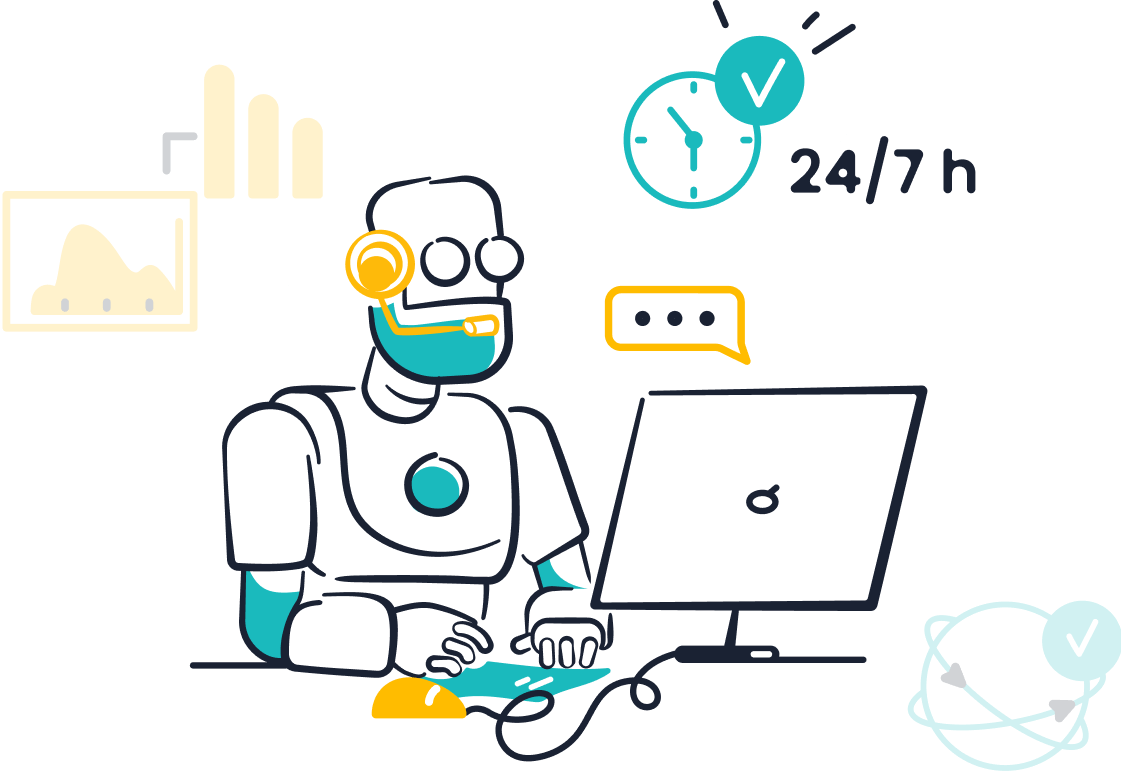
Sobot’s AI solutions, powered by LLMs, are designed to optimize contact center operations. For example, the Sobot AI Chatbot can handle routine queries 24/7, reducing the workload on human agents and cutting operational costs. This not only improves productivity but also ensures your customers receive timely, accurate responses.
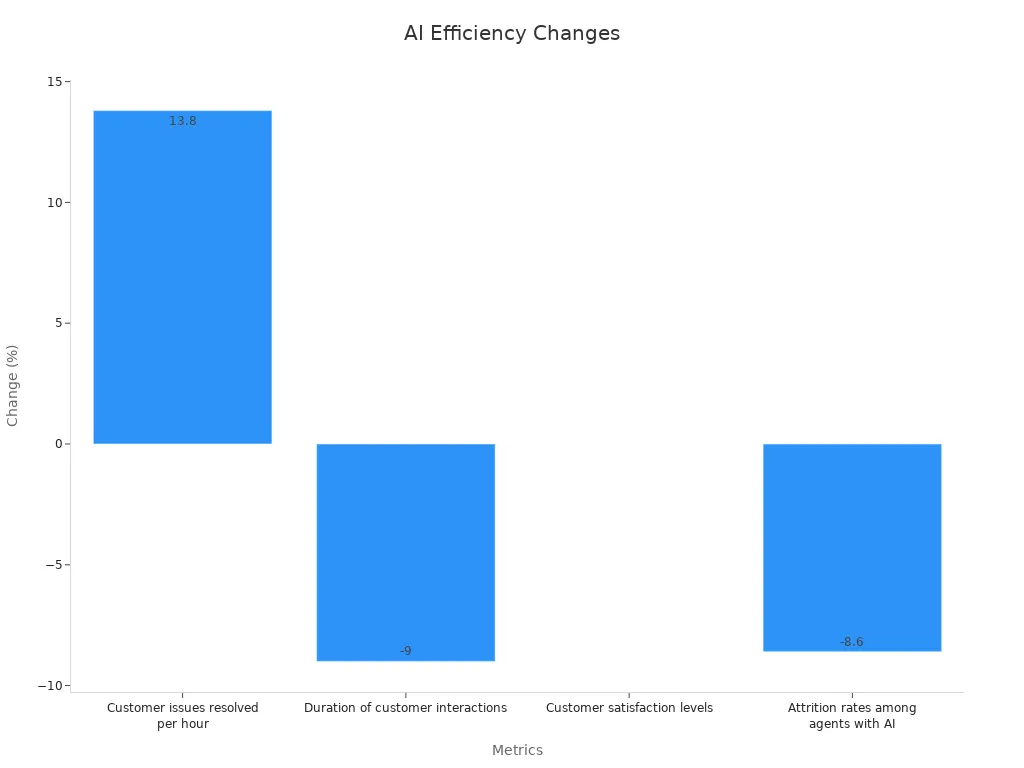
Note: Generative AI isn’t just about automation—it’s about creating smarter, more efficient workflows that benefit both your team and your customers.
Applications in Marketing and Customer Retention
Generative AI is revolutionizing how businesses approach marketing and customer retention. By leveraging its capabilities, you can create personalized experiences, predict customer needs, and engage with your audience in real time. Let’s explore how this technology can transform your strategies.
Personalizing Marketing Campaigns
Imagine being able to tailor every marketing message to match your customers' preferences. Generative AI makes this possible by analyzing customer data and creating personalized content. For example, it can segment your audience into groups based on their behavior, interests, or purchase history. This allows you to send targeted emails, recommend products, or even design ads that resonate with specific customer segments.
| Use Case | Description |
|---|---|
| Customer Segmentation | Generative AI algorithms group customers by shared traits for targeted campaigns. |
| Predictive Analytics | AI forecasts trends and anticipates customer needs for proactive engagement. |
| Conversational Marketing | Chatbots and virtual assistants enhance real-time customer interactions. |
With tools like Sobot’s AI Chatbot, you can take personalization to the next level. The chatbot uses generative AI to provide tailored responses across multiple channels, ensuring your customers feel valued and understood.
Predicting Customer Behavior
Generative AI doesn’t just react—it predicts. By analyzing patterns in customer behavior, it can forecast trends and identify potential churn risks. This means you can act before it’s too late. For instance, if a customer shows signs of losing interest, AI can trigger loyalty incentives like discounts or exclusive offers. These proactive strategies help you retain customers and build long-term relationships.
- AI predicts churn and enables timely engagement.
- Machine learning models analyze behavior to offer loyalty rewards.
- Generative AI helps you anticipate customer needs, keeping them engaged.
Enhancing Real-Time Engagement
Real-time engagement is crucial in today’s fast-paced world. Generative AI powers conversational marketing through chatbots and virtual assistants, enabling instant, context-rich interactions. Whether it’s answering a query, recommending a product, or guiding a customer through a purchase, AI ensures seamless communication.
Sobot’s AI Chatbot excels in this area. It operates 24/7, handling inquiries across platforms like WhatsApp, email, and social media. This omnichannel support not only improves customer satisfaction but also boosts your team’s efficiency. Plus, its multilingual capabilities make it perfect for engaging with a global audience.
Tip: Use generative AI to automate repetitive tasks and focus on building meaningful connections with your customers. It’s a win-win for both your business and your audience.
Driving Customer Loyalty
Retaining customers is more cost-effective than acquiring new ones. Generative AI helps you strengthen loyalty by delivering consistent, personalized experiences. For example, it can send reminders about abandoned carts, recommend complementary products, or even celebrate milestones like birthdays with special offers. These small gestures go a long way in building trust and loyalty.
A study found that businesses using AI for customer retention saw a 36% increase in repeat purchases. With Sobot’s AI solutions, you can achieve similar results by automating these interactions and ensuring every customer feels appreciated.
Did you know? Generative AI can reduce cart abandonment rates by optimizing promotional campaigns and providing real-time support during the checkout process.
By integrating generative AI into your marketing and customer retention strategies, you can stay ahead of the competition and deliver exceptional experiences. It’s not just about technology—it’s about creating meaningful connections that drive growth.
Advantages of Conversational AI for Customer Support
Improving Customer Support Efficiency with Sobot Chatbot
When it comes to customer support, efficiency is everything. Conversational AI, especially AI-generated chatbots like Sobot’s, can transform how you handle customer interactions. These chatbots take care of repetitive tasks, like answering FAQs, so your team can focus on more complex issues. This doesn’t just save time—it boosts productivity and ensures customers get quick, accurate responses.
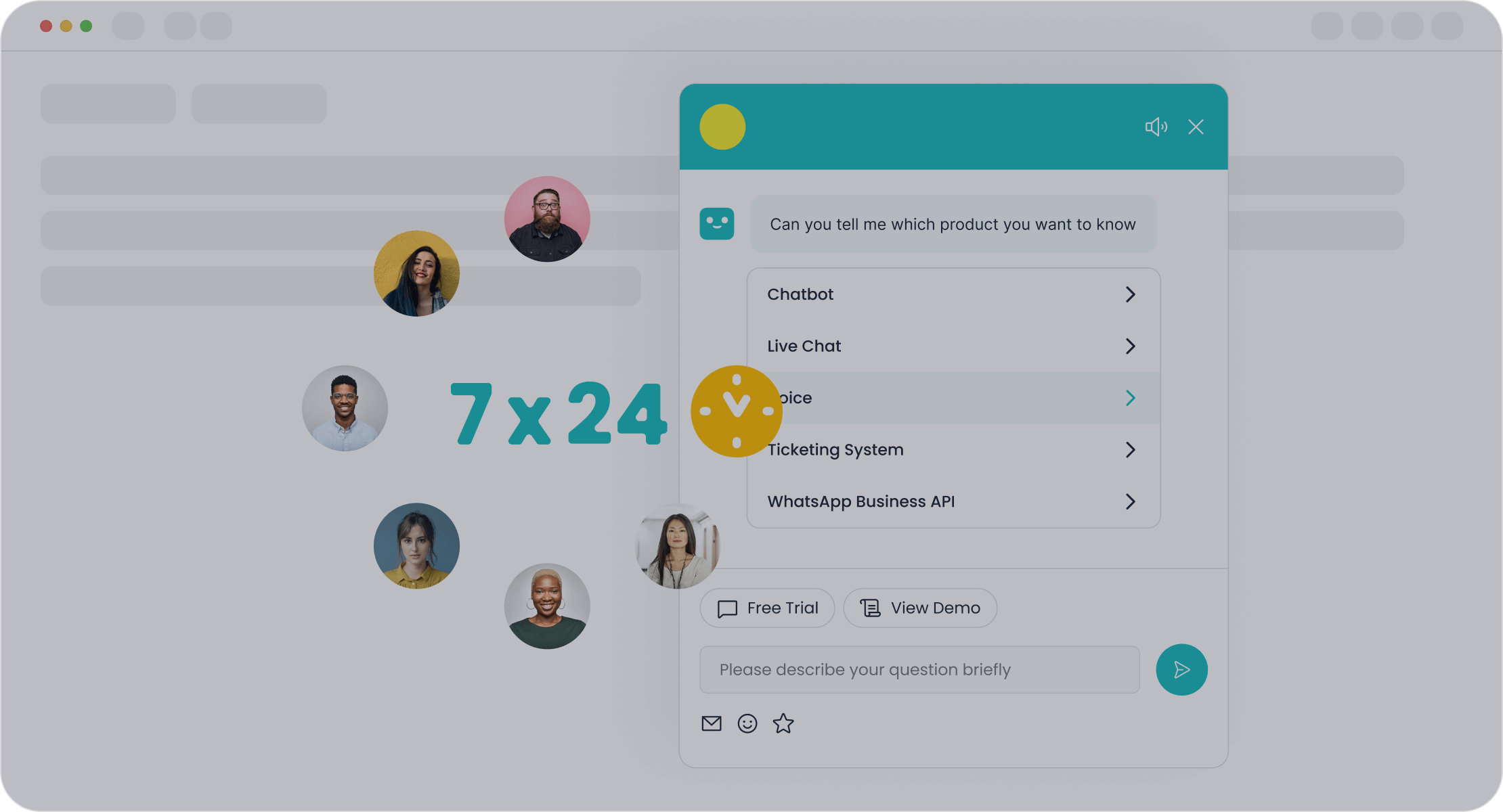
Sobot’s chatbot is a perfect example of how AI can improve efficiency. It uses intelligent recommendations and insights to help agents resolve issues faster. Plus, it scales effortlessly to handle fluctuating customer demands. Whether it’s a busy holiday season or a sudden spike in inquiries, the chatbot adapts without needing extra staff.
Here’s a snapshot of what Sobot’s chatbot can achieve:
| Metric | Improvement |
|---|---|
| Reduced inbound discussion volume | 20% |
| Increased positive feedback | 96% |
| Correct answers | Over 80% |
| Customer satisfaction | Over 95% |
| Self-service question resolution | 22.2% |
By automating routine tasks and providing data-driven insights, Sobot’s chatbot ensures your customer support team operates at peak efficiency. It’s not just about solving problems—it’s about doing it smarter and faster.
Pro Tip: Use chatbots to handle common queries and free up your team for high-value tasks. You’ll see a noticeable improvement in both efficiency and customer satisfaction.
24/7 Availability for Seamless Customer Interactions
Imagine a world where your customers never have to wait for help. That’s the power of conversational AI. AI-generated chatbots like Sobot’s operate around the clock, ensuring your customers can get assistance anytime, anywhere. This 24/7 availability is a game-changer, especially in today’s fast-paced world where immediate responses are expected.
Why does this matter? Studies show that 90% of customers prioritize immediate responses, and 60% want them in under 10 minutes. With Sobot’s chatbot, you can meet these expectations effortlessly. It handles inquiries across multiple channels—like WhatsApp, email, and social media—providing consistent support no matter where your customers are.
Here’s how 24/7 availability impacts customer interactions:
| Benefit | Statistic |
|---|---|
| Customer engagement | 98% occupancy rate for 24/7 service vs. 30% for 8-hour service |
| Immediate response needs | 90% of customers prioritize immediate responses, with 60% wanting it in 10 minutes or less |
| Willingness to pay for experience | 86% of buyers are willing to pay more for exceptional service |
With Sobot’s chatbot, you’re not just meeting customer expectations—you’re exceeding them. Whether it’s resolving an issue at midnight or answering a question during a lunch break, the chatbot ensures seamless interactions every time.
Did you know? Businesses with 24/7 customer support see higher engagement and loyalty. It’s a simple way to stand out in a competitive market.
Personalizing Customer Experiences Across Channels
Personalization is no longer optional—it’s essential. Customers expect brands to understand their needs and provide tailored experiences. Conversational AI makes this possible by analyzing customer data and delivering personalized interactions across multiple channels.

Sobot’s chatbot excels in this area. It uses AI and machine learning to customize responses based on customer preferences, purchase history, and behavior. Whether it’s recommending a product, sending a reminder about an abandoned cart, or answering a query in the customer’s preferred language, the chatbot ensures every interaction feels personal.
Here’s what personalization can achieve:
| Statistic | Source |
|---|---|
| 80% of executives reported improvements in customer satisfaction due to AI | MIT Technology Review |
| 80% of customers prefer brands that offer personalized experiences | Epsilon |
By integrating Sobot’s chatbot into your customer support strategy, you can deliver these personalized experiences seamlessly. The chatbot works across channels like WhatsApp, email, and social media, ensuring consistent communication no matter where your customers are.
Tip: Use AI-powered chatbots to analyze customer data and create personalized experiences. It’s a surefire way to boost satisfaction and loyalty.
Reducing Operational Costs in Call Centers
Running a call center can be expensive, especially when you factor in staffing, training, and infrastructure costs. But what if you could cut those expenses while improving efficiency? That’s where conversational ai steps in. By automating routine tasks and streamlining workflows, AI-powered tools like Sobot’s chatbot help businesses save money without compromising service quality.
Here’s how generative AI reduces operational costs:
- Automating Routine Queries: AI chatbots handle up to 70% of incoming queries without human intervention. This reduces the need for additional agents during peak times.
- Boosting Efficiency: Generative AI improves call center productivity by 30%, allowing your team to resolve more issues in less time.
- Lowering Costs per Call: The average cost per call ranges from $2.70 to $5.60. AI reduces handle time by 9%, cutting these costs significantly.
| Metric | Value |
|---|---|
| Cost per call benchmark | $2.70 - $5.60 |
| Increase in issue resolution | 14% per hour |
| Reduction in handle time | 9% |
| Estimated productivity boost | 30% - 40% of current costs |
Sobot’s AI Chatbot is a prime example of how automation can transform your call center. It operates 24/7, solving regular queries autonomously and triaging complex ones to human agents. This not only saves up to 50% on staffing costs but also ensures your customers get timely responses. Plus, its multilingual capabilities make it ideal for businesses with a global audience.
Pro Tip: Use AI to handle repetitive tasks and focus your resources on high-value interactions. You’ll see a noticeable drop in operational costs and a boost in customer satisfaction.
Leveraging generative AI doesn’t just save money—it creates smarter workflows. By minimizing human intervention, enhancing response times, and boosting agent productivity, you can optimize your call center operations and deliver better service at a lower cost.
Disadvantages of Generative AI in Business Applications
Ethical Considerations in Content Generation
Generative AI brings exciting possibilities, but it also raises ethical considerations that you can’t ignore. For instance, how do you ensure the content it generates aligns with your brand’s values and complies with regulations? AI systems often lack transparency, making it hard to trace how decisions are made. This can lead to trust issues, especially in industries like finance or healthcare, where accountability is critical.
Several studies highlight these challenges:
- Generative AI struggles with adhering to moral and ethical standards, especially in domain-specific applications.
- Transparency in decision-making remains a significant hurdle.
- Balancing responsibility between human agents and AI systems is still a gray area.
If you’re using tools like Sobot’s AI Chatbot, you can mitigate these risks by setting clear guidelines for AI usage. Always review the content it generates to ensure it meets your ethical standards. Remember, AI is a tool—it’s up to you to use it responsibly.
Tip: Establish ethical guidelines for AI implementation to build trust with your customers and stakeholders.
Risk of Misinformation and Bias in Outputs
Generative AI isn’t perfect. It can produce outputs that are biased or outright incorrect. This happens because AI models learn from existing data, which may already contain inaccuracies or stereotypes. For example, studies like the Gender Shades Project found that AI systems often perform poorly for darker-skinned females. Another case, Mata v. Avianca, showed how AI hallucinations led to fabricated legal citations.
Here’s a quick look at some findings:
| Evidence | Description |
|---|---|
| Gender Shades Project | Significant disparities in accuracy across genders and skin types. |
| Stable Diffusion Analysis | Amplifies gender and racial stereotypes. |
| Training Data Issues | Models replicate biases in their training data. |
| Design Limitations | AI predicts plausible content but doesn’t verify its accuracy. |
To avoid these pitfalls, you should regularly audit your AI systems. Tools like Sobot’s AI Chatbot allow you to customize responses, reducing the risk of misinformation. By combining AI with human oversight, you can ensure your customers receive accurate and unbiased information.
Did you know? Even with accurate training data, generative AI can still produce errors due to its design.
High Computational and Resource Costs
Generative AI is powerful, but it doesn’t come cheap. Training large language models requires massive computational resources, which translates to high costs. For example, developing these models can cost tens to hundreds of millions of dollars. Even after deployment, running AI systems involves significant expenses, especially for high-volume applications like customer support.
Here’s a breakdown of the costs:
| Aspect | Cost Estimate |
|---|---|
| Total AI Investment (2023) | $200 billion |
| Projected Investment (2024) | $250 billion |
| Cost of Developing LLMs | Tens to hundreds of millions |
Additionally, the infrastructure needed for AI—like data centers and semiconductors—requires substantial capital. If you’re considering generative AI for your business, tools like Sobot’s AI Chatbot offer a cost-effective solution. It operates efficiently, reducing the need for extensive resources while still delivering high-quality results.
Pro Tip: Start small with AI adoption to manage costs effectively. Scale up as you see measurable benefits.
Challenges in Intellectual Property and Data Ownership
Generative AI opens up exciting possibilities, but it also brings tricky questions about intellectual property (IP) and data ownership. Who owns the rights to content created by AI? Is it the developer, the user, or no one at all? These are questions businesses like yours need to consider before diving into AI-powered tools.
For example, AI-generated art installations in museums have sparked debates about ownership. If an AI creates a painting, does the credit go to the artist who trained the AI or the company that owns the software? These gray areas can lead to disputes, especially when the content has commercial value. The lack of clear legal frameworks makes it even harder to navigate.
Here’s where things get more complex. Generative AI learns from massive datasets, which often include copyrighted material. If your AI tool generates content based on this data, you might unknowingly infringe on someone else’s IP. This risk is especially high in industries like marketing or publishing, where originality is key.
To avoid these pitfalls, you need to choose AI solutions that prioritize compliance. For instance, Sobot’s AI Chatbot operates within strict ethical and legal guidelines. It uses secure, compliant data practices to ensure your business stays on the right side of the law. Plus, it’s customizable, so you can set boundaries for how it generates content.
Tip: Always review AI-generated content before using it. This simple step can save you from potential legal headaches.
Navigating IP and data ownership challenges isn’t easy, but it’s essential. By staying informed and choosing the right tools, you can harness the power of generative AI without compromising your business’s integrity.
Disadvantages of Conversational AI in Customer Service
Limited Understanding of Complex Customer Queries
Conversational AI can struggle when faced with complex context understanding. While it excels at handling straightforward questions, it often falters with nuanced or multi-layered queries. For instance, if a customer asks about a product’s compatibility with multiple devices or seeks advice on a unique situation, the AI might provide incomplete or irrelevant answers. This can lead to frustration and dissatisfaction.
Imagine a customer asking, “Can I use this software on both my MacBook and my Windows PC, and will it sync data between them?” A conversational AI might only address one part of the question, leaving the customer confused. To mitigate this, businesses often rely on hybrid systems like Sobot’s AI Chatbot, which seamlessly transfers complex queries to human agents. This ensures customers get accurate and comprehensive responses without delays.
Tip: Always monitor your AI’s performance and train it with diverse scenarios to improve its ability to handle complex queries.
Risk of Miscommunication in Customer Interactions
Miscommunication is another challenge with conversational AI. Sometimes, the AI misinterprets a customer’s intent or provides responses that lack clarity. This can happen due to ambiguous phrasing, slang, or regional language differences. Miscommunication not only frustrates customers but also impacts their trust in your brand.
Here’s how businesses measure and address this issue:
- Monitor QA alert signals to identify potential miscommunication.
- Conduct post-interaction analysis to spot patterns affecting customer satisfaction.
- Evaluate metrics like customer feedback ratings, response accuracy, and engagement levels.
For example, if a customer types, “I need help with my account,” the AI might respond with generic troubleshooting steps instead of asking clarifying questions. Sobot’s chatbot minimizes such risks by using advanced natural language processing (NLP) to understand intent better. It also allows for human intervention when needed, ensuring smoother interactions.
Pro Tip: Regularly review customer feedback to identify and fix recurring miscommunication issues.
Data Privacy and Security Concerns in AI Deployment
Data privacy is a significant concern when deploying conversational AI. These systems often collect and store vast amounts of customer data, which can pose risks if not managed properly. Unauthorized data collection or breaches can lead to legal and reputational issues.
Here are some key concerns:
- The AI market is projected to grow to $1.4 trillion by 2030, increasing the volume of sensitive data handled.
- Data collection without explicit consent violates privacy regulations like GDPR and CCPA.
- AI systems are vulnerable to cybersecurity threats, leading to potential breaches.
Additionally, issues like data persistence and repurposing can arise. For example, if customer data is stored indefinitely or used for purposes beyond its original intent, it could lead to misuse. Sobot’s AI solutions prioritize compliance by adhering to strict data protection standards. Features like encrypted backups and GDPR compliance ensure your customers’ information stays secure.
Did you know? Transparent AI operations build trust. Always inform customers about how their data is used and stored.
Dependence on High-Quality Training Data for Accuracy
When it comes to conversational AI, the quality of training data plays a huge role in how well it performs. Think of it like teaching a student. If the textbooks are full of errors, the student will learn incorrect information. Similarly, if the data used to train AI is flawed, the chatbot might give inaccurate or biased responses.
For example, a study on healthcare chatbots found that errors often happen because of poor training data. These chatbots sometimes provide wrong or incomplete answers, which can be risky in critical fields like healthcare. Until AI systems can reliably avoid these mistakes, human experts must verify the information they generate. This shows how much conversational AI depends on clean, accurate data to work effectively.
But here’s the tricky part—gathering high-quality data isn’t easy. It requires time, effort, and resources. Businesses need to ensure their data is diverse and free from biases. Otherwise, the AI might unintentionally favor certain groups or overlook others. For instance, if a chatbot is trained only on English data, it might struggle to understand slang or regional phrases in other languages.
Sobot’s AI Chatbot addresses this challenge by using a robust knowledge base built from reliable sources like articles, PDFs, and even customer FAQs. This ensures the chatbot provides accurate and helpful responses across multiple languages and channels. Plus, it’s customizable, so you can fine-tune it to meet your business needs.
Tip: Regularly update your AI’s training data to keep it accurate and relevant. This simple step can make a big difference in how well your chatbot performs.
In the end, high-quality training data isn’t just important—it’s essential. It’s the foundation that helps conversational AI deliver accurate, reliable, and unbiased responses, ensuring your customers have a smooth and satisfying experience.
Navigating Ethical Usage of Generative AI and Conversational AI
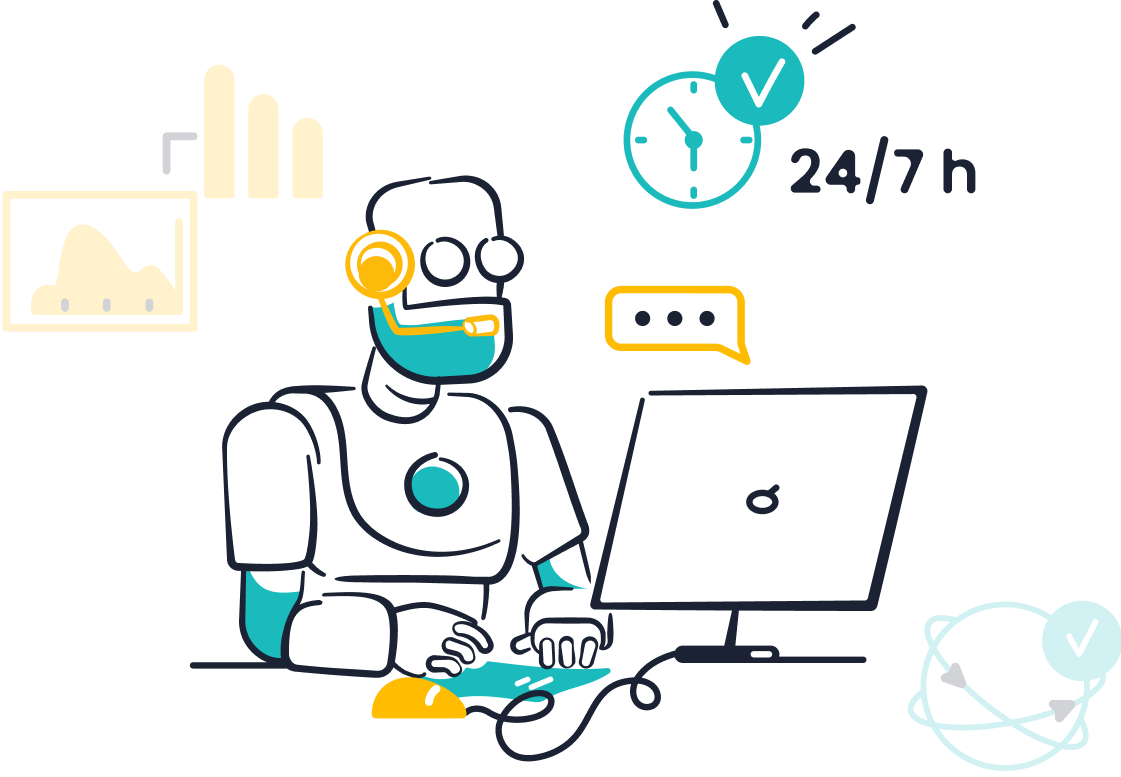
Establishing Ethical Guidelines for AI Implementation
When you’re adopting AI, setting clear ethical guidelines is essential. These guidelines ensure your AI systems align with your business values and societal expectations. Without them, you risk losing trust and facing legal challenges. Frameworks like the EU AI Act, NIST AI Risk Management Framework, and OECD AI Principles provide excellent starting points.
| Framework | Key Features |
|---|---|
| EU AI Act (2024) | Implements a risk-based classification system for AI applications, with fines for violations up to 6% of global revenue. |
| NIST AI Risk Management Framework | Provides voluntary guidelines for building trustworthy AI systems. |
| OECD AI Principles | Establishes global ethical AI standards focused on human-centric development. |
For example, the EU AI Act emphasizes transparency and accountability, requiring businesses to disclose key details about their AI systems. By following these frameworks, you can create an implementation strategy that prioritizes responsible AI usage. This not only builds trust but also ensures your AI solutions deliver value without compromising ethics.
Tip: Start by defining your ethical boundaries and train your team to follow them. This simple step can make a big difference in navigating ethical usage.
Ensuring Transparency and Accountability in AI Applications
Transparency is the backbone of trust in AI. When your customers understand how your AI works, they’re more likely to trust it. Practices like MLOps (Machine Learning Operations) integrate accountability into the AI lifecycle, ensuring your systems remain ethical and aligned with societal values.
Here’s how you can enhance transparency and accountability:
- Disclose how your AI systems make decisions.
- Conduct regular audits to ensure fairness and accuracy.
- Use tools like feature importance analysis and rule extraction to explain AI outputs.
| Framework | Description |
|---|---|
| EU AI Act | Requires disclosure of key characteristics of high-risk AI systems, including training data and performance metrics. |
| Algorithmic Accountability Act | Mandates impact assessments for high-risk automated decision systems in sensitive domains. |
Sobot’s AI Chatbot, for instance, operates transparently by providing clear explanations for its responses. This builds trust and ensures your customers feel confident using the system.
Did you know? Transparency isn’t just about compliance—it’s about showing your customers you care about their experience.
Prioritizing Data Security and Privacy in AI Solutions
Data privacy is a top concern when using AI. With the global average cost of a data breach reaching $4.88 million in 2024, you can’t afford to overlook security. AI systems can help by identifying and mitigating risks in real time.
AI systems can provide real-time identification and mitigation of risks through continuous monitoring and analysis of user behavior, which is essential for maintaining data privacy and security.
However, human error remains a significant challenge. Studies show that 74% of data breaches involve mistakes like misdelivery or misconfiguration. Sobot’s AI solutions address this by using encrypted backups and GDPR-compliant practices, ensuring your customers’ data stays safe.
A study by Tessian Security and Stanford University highlights how AI reduces reliance on human error, especially during remote work transitions. By automating data protection, you can focus on delivering value to your customers without worrying about security risks.
Pro Tip: Regularly update your AI systems to stay ahead of evolving threats. This keeps your data secure and your customers happy.
Balancing Automation with Human Oversight in Customer Service
Automation has revolutionized customer service, but it’s not a one-size-fits-all solution. While AI-powered tools like chatbots handle repetitive tasks efficiently, they can’t replace the human touch. Finding the right balance between automation and human oversight is key to delivering exceptional customer experiences.
Why does this balance matter? Automation shines when it comes to speed and efficiency. It can answer FAQs, process orders, and even provide 24/7 support. But when customers face complex issues or need emotional support, human agents step in to build trust and empathy. For example, a chatbot might quickly resolve a billing query, but only a human can navigate a sensitive complaint with care and understanding.
Here’s how you can strike the perfect balance:
- Boost Efficiency with Automation: Use AI tools like Sobot’s Chatbot to handle routine queries. This frees up your team to focus on high-value interactions. Sobot’s Chatbot, for instance, improves productivity by 70% while cutting costs by up to 50%.
- Leverage Human Empathy: Reserve human agents for situations requiring emotional intelligence or ethical judgment. Customers value genuine connections, especially during challenging moments.
- Ensure Continuous Improvement: Human oversight is essential for refining automated systems. Regularly review chatbot performance and update training data to maintain accuracy and relevance.
Did you know? Businesses that combine automation with human oversight see higher customer satisfaction rates. A hybrid approach ensures efficiency without losing the personal touch.
By integrating automation and human expertise, you can meet customer needs more effectively. Tools like Sobot’s AI solutions make this easier by seamlessly blending automation with human support. This approach not only enhances customer satisfaction but also builds lasting loyalty.
Generative AI and conversational AI have reshaped how businesses interact with customers. Generative AI boosts creativity, personalizes experiences, and automates tasks, saving time and costs. However, it faces challenges like ethical concerns, data security risks, and occasional inaccuracies. Conversational AI excels in improving efficiency, offering 24/7 support, and personalizing interactions. Yet, it struggles with complex queries and depends heavily on high-quality training data.
To maximize the benefits and minimize the risks, you need a balanced approach. Adopt AI responsibly by setting ethical guidelines, ensuring transparency, and prioritizing data security. Tools like Sobot’s AI Chatbot can help you automate customer interactions efficiently while maintaining trust and satisfaction. By combining AI with human oversight, you can deliver exceptional service and build lasting customer relationships.
Tip: Start small with AI integration and scale as you see results. This ensures a smooth transition and measurable success.
FAQ
1. What’s the difference between generative AI and conversational AI?
Generative AI creates content like text or images based on patterns it learns. Conversational AI focuses on having human-like chats with users. For example, Sobot’s AI Chatbot uses conversational AI to answer customer queries, while generative AI helps craft personalized responses. Both improve customer service efficiency.
2. How does Sobot’s AI Chatbot personalize customer interactions?
Sobot’s AI Chatbot analyzes customer data to tailor responses. It remembers preferences, recommends products, and even interacts in multiple languages. This personalization boosts satisfaction and loyalty. For example, it can remind customers about abandoned carts or suggest complementary items based on past purchases.
3. Can conversational AI handle complex customer queries?
Conversational AI struggles with nuanced questions. However, Sobot’s AI Chatbot transfers complex issues to human agents seamlessly. This hybrid approach ensures customers get accurate answers without delays. For instance, it handles FAQs autonomously but escalates technical problems to trained staff.
4. Is Sobot’s AI Chatbot secure for customer data?
Yes, Sobot prioritizes data security. Its AI Chatbot complies with GDPR and uses encrypted backups to protect sensitive information. This ensures your customers’ data stays safe while you enjoy the benefits of AI-powered customer service. Learn more about GDPR compliance here.
5. How can generative AI reduce customer service costs?
Generative AI automates repetitive tasks, cutting staffing needs. Sobot’s AI Chatbot operates 24/7, solving regular queries autonomously. This reduces costs by up to 50%. For example, businesses save on hiring extra agents during peak seasons while maintaining high service quality.
See Also
Essential Tips for Selecting Top Chatbot Solutions
Evaluating AI Solutions for Enterprise Call Centers
Steps to Build a Successful Website Chatbot
